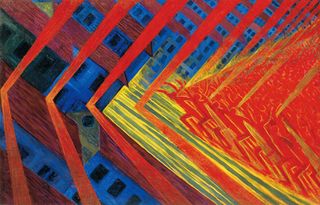
In the early 20th Century there was a band of wild men who created an entire new way of thinking about “Art.” They were called Futurists and for those of you who took Art 11 and already know about them, I understand that I didn’t discover them – this being particularly true since they are currently appearing in a retrospective at the Tate Modern here in London. AND for my penultimate (I think) post here I want to tell you about them because they were a real kick.
This painting, by Luigi Russolo, is called “The Revolt.” On the right you can see “the people” pushing up against the hard line of the establishment. It’s the same thing the Futurists themselves were doing. Here’s their major “Manifesto.”
These are our final conclusions:
With our enthusiastic adherence to Futurism, we will:
- Destroy the cult of the past, the obsession with the ancients, pedantry and academic formalism.
- Totally invalidate all kinds of imitation.
- Elevate all attempts at originality, however daring, however violent.
- Bear bravely and proudly the smear of “madness” with which they try to gag all innovators.
- Regard art critics as useless and dangerous.
- Rebel against the tyranny of words: “Harmony” and “good taste” and other loose expressions which can be used to destroy the works of Rembrandt, Goya, Rodin…
- Sweep the whole field of art clean of all themes and subjects which have been used in the past.
- Support and glory in our day-to-day world, a world which is going to be continually and splendidly transformed by victorious Science.
The dead shall be buried in the earth’s deepest bowels! The threshold of the future will be swept free of mummies! Make room for youth, for violence, for daring!
As I wandered through, alone and more available for being by myself, (this one is Carra’s The Funeral of an Anarchist) I felt that I knew these guys. Yes they denigrated women (more on that in a second) but their rebellion, their anger, their passion, their desire to change everything – that was familiar. Of course I never wanted to destroy; none of us did. But the feelings of anger, of disappointment in the ways of the world, the desire to find new ways to say things, those were familiar — and swept me back to the determined, impassioned girl I was then. I can only describe my reaction as delight.
You’re going to tell me that this is the kind of blind passion is just what was wrong with the 60’s. And for those who transformed these feelings not into art but into primitive acts of violence – they were wrong then and they’re wrong now. That’s what is so amazing about art. You can act, and express, through representation instead of concrete acts of violence and hatred. That’s what these enraged men did. Meanwhile, the women artists were pretty angry, as you can imagine. One of them, Valentine de Saint-Point, although she agreed with their ideas, had some of her own to go along with them. Like this:
“Women
are Furies, Amazons, Semiramis, Joans of Arc, Jeanne Hachettes, Judith
and Charlotte Cordays, Cleopatras, and Messalinas: combative women who
fight more ferociously than males, lovers who arouse, destroyers who break down
the weakest and help select through pride or despair, “despair through
which the heart yields its fullest return.”
I wish I knew more because there’s so much more to this; the impact of Cubism on all
of it, the way it affected artists in nation after nation, and, most of all, the sheer energy of
art that, instead of freezing a moment, seems to set it free and follow it.








